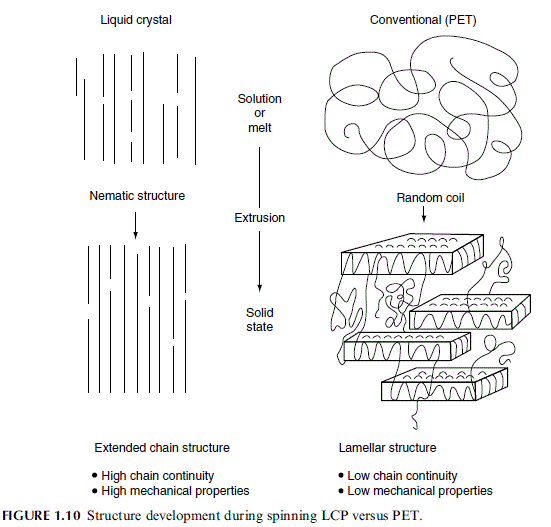Free Textile Article
All about textile & FiberFree Textile Article
All about textile & FiberChemical Structure of LCPs
Thermotropic polyester backbone chemistry is characterized by a high degree of aromaticity,
planarity, and linearity in the chain backbone. Most common moieties are p-phenylene, 1,4-
biphenyl, and 2,6-naphthalyl moieties linked by ester or amide linkages. Polymers that form
liquid crystal phases in the melt are thermotropic, whereas those that form liquid crystalline
phases in solution are lyotropic. The all-aromatic polyester homopolymers tend to be intractable,
decomposing at temperatures well below their melting points and insoluble in most

planarity, and linearity in the chain backbone. Most common moieties are p-phenylene, 1,4-
biphenyl, and 2,6-naphthalyl moieties linked by ester or amide linkages. Polymers that form
liquid crystal phases in the melt are thermotropic, whereas those that form liquid crystalline
phases in solution are lyotropic. The all-aromatic polyester homopolymers tend to be intractable,
decomposing at temperatures well below their melting points and insoluble in most

solvents. Successful melting point reduction strategies include incorporation of comonomers
to lessen crystal packing, decrease chain linearity, and increase chain-to-chain distance. All
these approaches lower the polymer melting point and, when the melting temperature is
reduced to below the polymer decomposition temperature, stable melt processing is possible.
These approaches have led to large numbers of melt processable thermotropic polyesters.
Typical LCP monomer and polymer chemistries of industrial importance are shown in
Figure 1.11. Much of the cost of LCP fibers is the result of high monomer cost and limited
monomer availability.
to lessen crystal packing, decrease chain linearity, and increase chain-to-chain distance. All
these approaches lower the polymer melting point and, when the melting temperature is
reduced to below the polymer decomposition temperature, stable melt processing is possible.
These approaches have led to large numbers of melt processable thermotropic polyesters.
Typical LCP monomer and polymer chemistries of industrial importance are shown in
Figure 1.11. Much of the cost of LCP fibers is the result of high monomer cost and limited
monomer availability.
برای نمایش آواتار خود در این وبلاگ در سایت Gravatar.com ثبت نام کنید. (راهنما)






















































ایمیل شما بعد از ثبت نمایش داده نخواهد شد